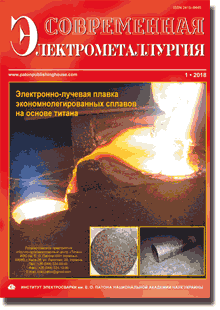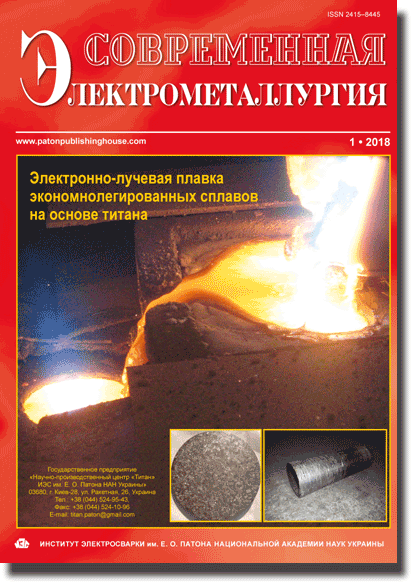| 2018 №01 (03) |
DOI of Article 10.15407/sem2018.01.04 |
2018 №01 (05) |

Electrometallurgy Today (Sovremennaya Elektrometallurgiya), 2018, #1, 28-36 pages
Mathematical model of plasma-induction process for growing single crystals of refractory metals
A.N. Gnizdylo1, V. V. Yakusha1, V. A. Shapovalov1, O. V. Karuskevich1, Yu. A. Nikitenko1, N. V. Kozub2
1E.O. Paton Electric Welding Institute of the NAS of Ukraine. 11 Kazimir Malevich Str., 03150, Kyiv, Ukraine. E-mail: office@paton.kiev.ua
2NTUU «Igor Sikirsky KPI». 37 Pobedy Ave., 03056, Kyiv, Ukraine
A mathematical model of plasma-induction melting was developed and implemented in the joint solution of electromagnetic and thermal problems in accordance with the technological scheme of growing single crystals of tungsten and correction of its parameters based on the data of the full-scale experiment, was made. Data of characteristics of the thermal pattern in the form of temperature and gradient fields were obtained with a sufficient accuracy for practical purposes, including those in the high-temperature region of a single crystal of tungsten, which is of great importance in connection with the existing difficulties in obtaining them by other methods of measurement. A mathematical modeling technique has been developed that allows predicting the optimal technological parameters on the basis of the thermal picture analysis with a change of parameters of the geometry of a single-crystal ingot and the design of an electromagnetic system over a wide range. Recommendations are given for the development of new technologies aimed at expanding the range of refractory single crystals with ensuring high productivity and economic efficiency. Ref. 12, Fig. 6.
Key words: mathematical model; modeling; plasma-induction method; profiled single crystal of tungsten; additive technology; temperature field
Received: 29.02.18
Published: 20.03.18
References
- Gnizdylo, A.N. (2015) Prospects and updating of plasma-induction technology of growing of refractory metal single crystals. Electrometall., 3, 16–22 [in Russian]. https://doi.org/10.15407/sem2015.03.03
- Shapovalov, V.A. (2002) Model of induction heating for plasma-induction growing of single-crystals. Advances in Electrometallurgy, 1, 27–31.
- Shapovalov, V.A. (2002) Heat model of plasma-arc process of growing tungsten single-crystals. Ibid., 3, 17–20.
- Tamm, I.E. (1980) Fundamentals of the theory of electricity. Central Books Ltd [in Russian].
- Landau, L.D., Lifshitz, E.M. (1979) Course of theoretical physics. Volume 8. Electrodynamics of Continuous Media. Butterworth-Heinemann [in Russian].
- Nemkov, V.S., Demidovich, V.B. (1988) Theory and calculation of induction heating devices. Leningrad, Energoatomizdat [in Russian].
- (1985) Drits, M.E. (ed.) Element properties. A handbook. Moscov, Metallurgy [in Russian].
- Marmer, E.N., Gurvich, O.S., Mal’tseva, L.F. (1967) High-temperature materials. Moscow, Metallurgiya [in Russian].
- Zinoviev V. E. (1989) Thermal properties of metals at high temperatures. Handbook. Moscow, Metallurgiya [in Russian].
- Shapovalov, V.A., Kovalenko, A.A., Sheiko, I.V., Zholud, V.V. (1993) The influence of technological parameters on the appearance of defects in the layer-by-layer formation of large profiled single crystals of refractory metals. Problemy Spets. Elektrometallurgii, 4, 54–57 [in Russian].
- https://www.comsol.com/
- Shapovalov, V.A., Yakusha, V.V., Nikitenko, Yu.A. et al. (2014) Studying the temperature field of profiled tungsten single-crystals produced by plasma-induction process. Electrometall., 3, 31–35 [in Russian].
The cost of subscription/purchase order journals or individual articles
| Journal/Currency | Annual Set | 1 issue printed |
1 issue |
one article |
| TPWJ/USD | 384 $ | 32 $ | 26 $ | 13 $ |
| TPWJ/EUR | 348 € | 29 € | 24 € | 12 € |
| TPWJ/UAH | 7200 UAH | 600 UAH | 600 UAH | 280 UAH |
| AS/UAH | 1800 UAH | 300 UAH | 300 UAH | 150 UAH |
| AS/USD | 192 $ | 32 $ | 26 $ | 13 $ |
| AS/EUR | 180 € | 30 € | 25 € | 12 € |
| SEM/UAH | 1200 UAH | 300 UAH | 300 UAH | 150 UAH |
| SEM/USD | 128 $ | 32 $ | 26 $ | 13 $ |
| SEM/EUR | 120 € | 30 € | 25 € | 12 € |
| TDNK/UAH | 1200 UAH | 300 UAH | 300 UAH | 150 UAH |
| TDNK/USD | 128 $ | 32 $ | 26 $ | 13 $ |
| TDNK/EUR | 120 € | 30 € | 25 € | 15 € |
AS = «Automatic Welding» - 6 issues per year;
TPWJ = «PATON WELDING JOURNAL» - 12 issues per year;
SEM = «Electrometallurgy Today» - 4 issues per year;
TDNK = «Technical Diagnostics and Non-Destructive Testing» - 4 issues per year.





